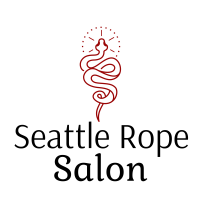Origins
Seattle Rope Salon was founded in 2021 by Pallace Garza, a transfemme Chicana, in order to create a brave space for queer rope bondage. A student of Shibari since 2017, she has trained in NYC, L.A., Berlin, and Seattle. Her emphasis is on therapeutic sub-space and semenawa, divine agony, to treat all sorts of mental disorders. With over 10 years of teaching experience she can accommodate a wide range of learning styles to transmit her playful passion for rope.
….and she loves ALL things rope. Her direct teachers and inspirations have included Tamandua, Kasumi Hourai, Saara Kantanen, Kirigami and Tenshiko, Fuoco, Sydona, Nawashi Kanna, Yagami Ren, Nureki and Naka, Hajime Kinoko, Banane, and Riccardo Wildties and Alé. The salon is a brave space for everyone but in particular, it is intended as a kinky haven for queer people and people of color. Pallace is also an Ayurvedic practitioner, Licensed Massage therapist, and BDSM photographer available for collaborative projects. “Our rope family is a kaleidoscope, constantly evolving and growing with time.”
Philosophy: Rope and Stick
The “Rope” along with the “Stick, are two of mankind’s oldest tools. The stick to keep the bad away, the rope used to bring the good toward us. They were our first friends, of our own invention. Wherever there were people, there were the rope and the stick. —Kobo Abe “Nawa”
-
It all begins with consent. “The term “consent” means the affirmative, unambiguous and voluntary agreement to engage in a specific activity .” Trust, on the other hand, is more of a spectrum rather than a binary. Practicing Rope Bondage (Shibari/Kinbaku) requires both consent and trust. Remember: Consent can be withdrawn at anytime, by the Rope Top (Rigger/Nawashi) or Bottom. Consent often looks like enthusiastic participation and it’s constantly evolving in real-time. Therefore, here at Seattle Rope Salon, we check-in with the people we tie so as to ensure their physical and psychological well-being all throughout the rope sessions. However, Rope Bondage has inherent risks, it’s important to educate yourself beforehand so all parties can consent with utmost confidence.
-
It’s finally time to address something. My reputation has been sullied for my association with a Seattle-based rigger named Namor Kinbaku. I want to remind everyone that rope tops, like myself, can also be deceived and abused by other rope tops. He is a white man who was using me and my talents, exploiting a transgender woman of color, for his own personal gain. I regret this. As an apology, I have dedicated the last 4 years to teaching queer intimacy coursework and healing my community. I am taking his knowledge and making it grow in a way he himself could never do, as an abuser and predator. If you have heard bad things about me, please know that the Seattle Rope scene is very gossipy and they rarely have all the facts. Don’t be a fascist and call me a groomer when you do not know me. I am filled with Love and Light and I will strike you down by the power of Orisha for speaking out against me. Trust the divine African powers will destroy you and everything you hold dear for slandering my name, white man! Aho! *hummingbird flies past my window
-
I define myself as a soft sadist. I let the rope do the work. I prefer the delicate trembling, drooling, whimpering, and melting of a successful scene. In a photo-session, I can take on a focused and distantly humble demeanor, to not distract from the natural reactions of a bottom’s experience. Whereas private sessions are much more co-collaborative. I have been called nurturing and encouraging, a mean mommy, to help people expand their limits, perceptions, and sensations.
-
Rope Bondage isn’t all about eroticism. For many people it’s a type of compression therapy. Temple Grandin pioneered the use of compression therapy in humans and animals to treat states of hyper-arousal and anxiety. There are several types of deep pressure therapy including weighted garments, swaddling, cuddling, squeezing, and therapeutic brushing. Rope bondage engages the Parasympathetic Nervous system, causing the body to relax and regenerate.
-
Translated roughly “Blaming Rope”. This is an advanced form of rope bondage that is best suited for experienced rope tops and bottoms. It is characterized by strict postures, rough rope, intense tension, and erotic predicaments. Riccardo Wildties says: “torture starts when you are passing the threshold of “what is enough”. It is in the moment in which an ordinary bondage scene would stop that torture starts.” The submissive head-space achieved here is profound, but it can make consent much more important yet more difficult to navigate as trust becomes the main currency involved. The truth is that during Semenawa people can sometimes dissociate or experience unlocked emotions, so the people involved should intimately know each others’ subtle physical cues and signals (i.e anatomy/safe-words). In this way, it is important to facilitate psychological aftercare.
-
Personally, I find the typical western aesthetic of male dominance to be rather repetitive and boring. This theatrical heteronormativity is all pervasive in the industry and on a foundational level is actually quite harmful. I find queer expressions of power and gender to be more fascinating. Ultimately, the rigger’s ego cannot be bigger than the intended goal: provide intensity for your bottom.



